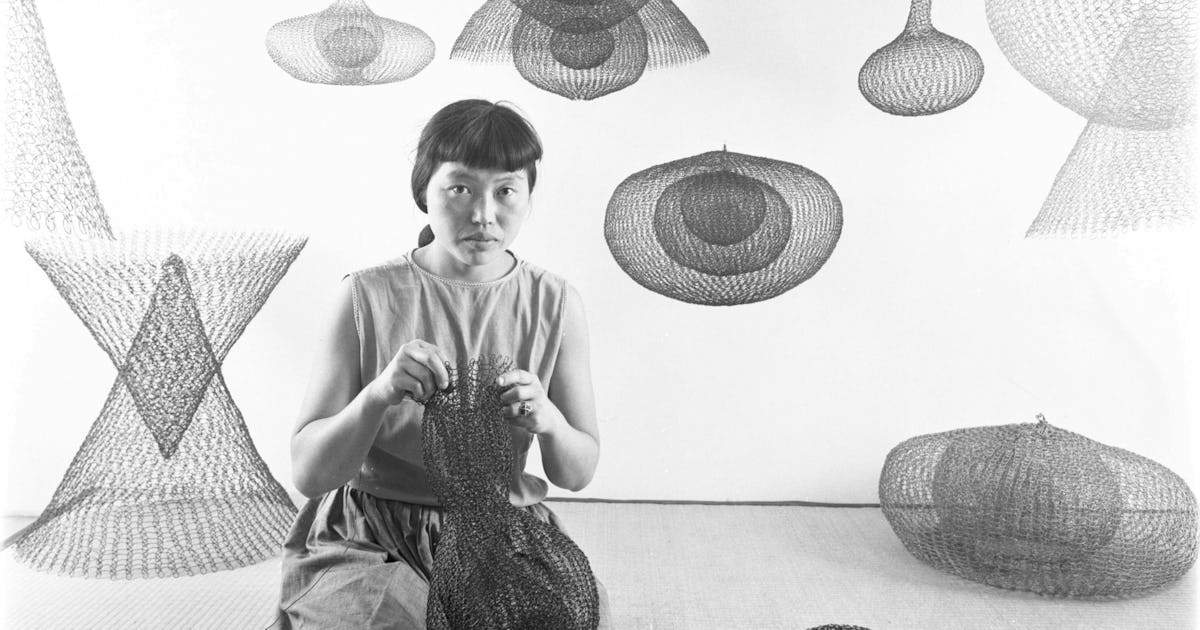A retrospective must encapsulate the full scope of an artist’s achievements in one space—an exhaustive checklist is not enough. So what happens when the artist’s narrative isn’t straightforward? How do you get your arms around work that breaks core binaries like ground and figure, negative and positive? And what if the work pauses time altogether?
All of these issues complicated the five-year planning of Ruth Asawa’s first U.S. retrospective, which is currently on view at San Francisco’s SFMoMA through September 2, 2025. Chief curator Janet Bishop and MoMA associate curator Cara Manes, the co-organizers of “Ruth Asawa: Retrospective,” wanted to show how deeply the Bay Area legend’s practice was interconnected. In this case, “interconnected” refers both to the fluid way Asawa shifted between mediums—from her biomorphic drawings to her iconic hanging wire sculptures—but also to the way she wove together art-making with life-making.
To illustrate this idea, an image from the 1960s comes to mind: Asawa, playing with baked clay forms alongside her children at the kitchen table, while dinner simmers on the stove. Being and art shared one continuum in her house—and Asawa’s family members were not the only collaborators the Japanese-American artist gathered around her. Asawa was a lifelong educator and arts education advocate. In 1968, she founded a nonprofit devoted to art accessibility for schoolchildren, and went on to help create the San Francisco School of the Arts in 1982, a high school devoted to fostering young talent.
Ruth Asawa teaching a Baker’s Clay workshop at the San Francisco Museum of Art (now SFMoMA), 1973.
Photo courtesy of Ruth Asawa Lanier, Inc.
Asawa spent her life out in the world, serving others—a calling she never sought to separate from her sculpture and drawings. In the Bay Area, there are monuments all over the city by Asawa that provide concrete examples of the artist’s priorities. It is especially interesting to think of her actions in conversation with a peer like Donald Judd, who spent so much time elaborating on his own properties.
At the inauguration of the show at SFMoMA in April, the legacy of Asawa’s community filled the room. The opening had a warmth that permeated the galleries thronged with Asawa’s students, friends, neighbors, and family—all of whom were ultimately instrumental in putting together the oral history that helped fill in the gaps left between Asawa’s work, recorded interviews, and notebooks. “[Asawa] felt alive for us throughout the process, first and foremost,” curator Manes says. “We are very lucky to be able to engage deeply with the artist’s five surviving children, but I got to know her through the work, because it is so immediate and generous. The sketchbooks tell you where she was, how she was feeling, who she saw. It gave me the feeling I was as well-equipped as one could be when having a conversation with the infinite.”


When thinking about how to present Asawa’s unwieldy archive, Manes found herself often returning to Asawa’s description of early work as “continuous forms within forms.” This led her to a hybrid shape for the show, somewhere between a traditional biography and something more thematically driven. In speaking to Manes about the exhibition, abundance, repetition and evolution are recurring themes. Asawa liked her works to be in conversation with each other, and the way these thematic threads accumulated when more than two were in the mix was often evident, especially at her studio in Noe Valley and in her seminal 1973 mid career survey. Both the latter show and the current one frequently depart from strict chronology to bore down on a specific work, idea or place; the effect is to encourage viewers to see how Asawa’s work always wrestled with the unknowable.
Inside “Ruth Asawa: Retrospective.”
Photograph by Henrik Kam

Undermine your certainties, the work seems to say, and clear some room to learn. The show gives it room to speak, allowing Asawa to tell the expansive and complicated story of her life through the art she made alongside it.

